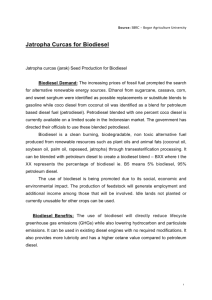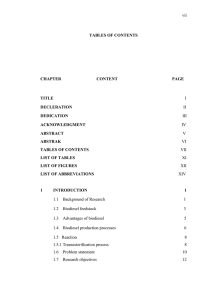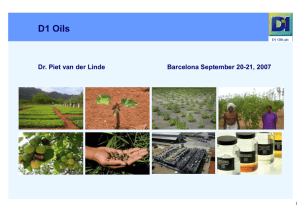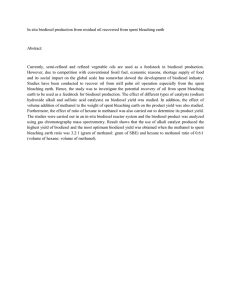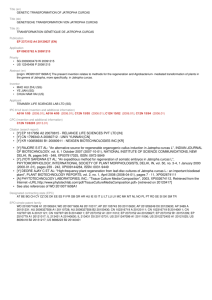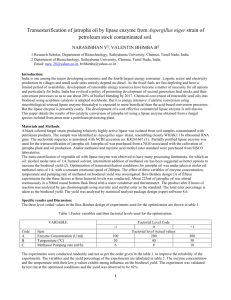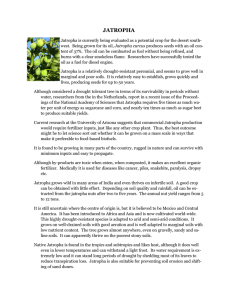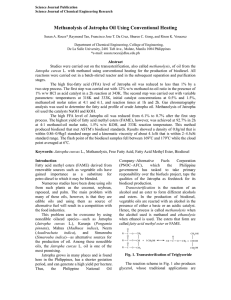PRESENTATION NAME
advertisement
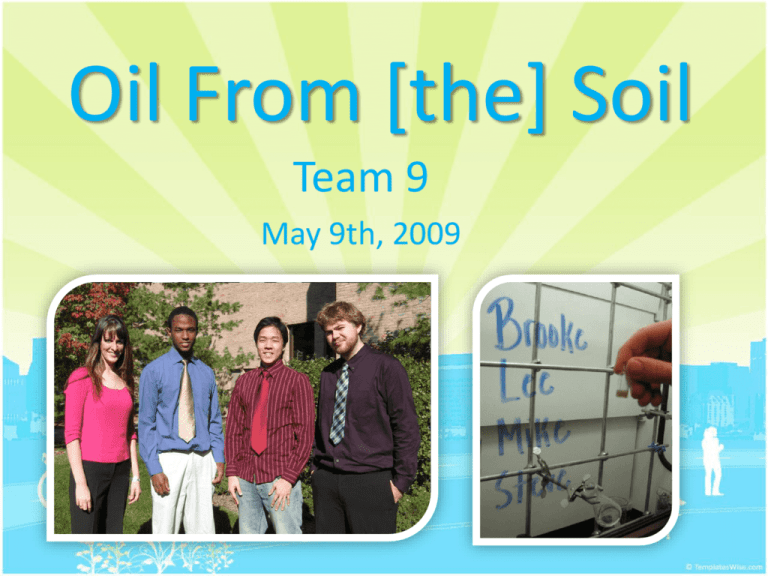
Oil From [the] Soil Team 9 May 9th, 2009 Outline • Project Selection • Tasks Accomplished • Challenges Overcome • Lessons Learned • Acknowledgements • Questions Project Selection • Provided global industrial perspective • Utilized and built upon prior coursework - Separation Processes - Reactor Design - Fluid Flow & Momentum Transfer Phenomena • Received suggestions from Professor Sykes • • Waste vegetable oil from food operations Biological conversion of CO2 to ethanol by sunlight Our Design Process 1. Research a. What is Jatropha Curcas? b. How is biodiesel produced? c. Why Jatropha? What is Jatropha Curcas? • Grown in South America, Africa, India • Ideal for poor soil and water conditions • Seed’s mass is 30%- 40% oil 1 meter How is Biodiesel Produced? • Common process for various sources – Soybeans – Recycled cooking oil • Base-catalyzed transesterification Why Jatropha? Property Conventional Diesel Jatropha Biodiesel Density (kg/m3) 850 880 Viscosity (mm2/s) 2.60 4.80 68 135 0.020 0.025 Flash point (˚C) Water Content (%) 1000 kg Jatropha seeds = 92 gallons biodiesel Our Design Process 1. Research 2. Develop a. Process design with bench-scale trials Start Bench-Scale Design Whole Jatropha Seeds Crushed Jatropha Seeds Hexane Separated evaporated Glycerol with heat Hexane-Seed Slurry Acid-Catalyzed Base-Catalyzed Purified & Biodiesel Transesterification Transesterification Biodiesel Our Design Process 1. Research 2. Develop a. Design overall process with bench-scale trials b. Pilot plant simulation of chosen process UniSim Design • Simulated a biodiesel production pilot plant • Produces 2 million gallons annually The Process Seed Oil Extraction Treatment & Conversion (Transesterification) Hexane & Methanol Recovery Step 1: Extraction To Step 2 Step 2: Treatment & Conversion From Step 1 Treatment Conversion Step 3: Hexane and Methanol Recovery Hexane Recovery Methanol Recovery Our Design Process 1. Research 2. Develop 3. Overcome a. Address emerging challenges b. Evaluate existing components Challenges Overcome • Troubleshooting UniSim design • Unexpected & undesired experimental outcomes • Accounting for entire footprint – Equipment sizing & material science – Economic analysis – Responsible design Responsible Design • Chemical safety – Flammability – Working conditions – Safe handling • Waste management – Hexane & methanol recycling – Seed cake incineration – Sale of glycerol Lessons Learned & Future Work • Value of teamwork – Communication – Individual strengths/weaknesses • Project management – “You break it, you bought it” • Future work: Commercialize Thank You To… • • • • • Professor Sykes, Faculty Advisor Professor Wentzheimer, UniSim Dr. David Dornbos, Industrial Consultant Rich Huisman, Equipment Michigan State University, Equipment Thank You!
